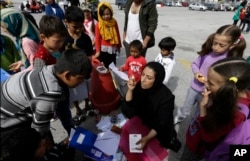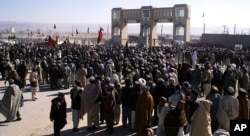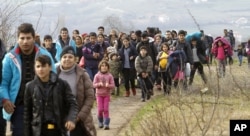Afghanistan will reportedly take in more than 1.5 million Afghan refugees by the end of the year, challenging the government at a time when Kabul is already struggling against resurgent Taliban militants and an emerging Islamic State group (IS).
Based on figures compiled by the United Nations Refugee Agency (UNHCR), some 20 percent of Afghanistan's population already are former refugees known as "returnees." Many of them, along with internally displaced Afghans and Afghans living in "refugee like" conditions, are part of a group of people the United Nations calls "people of concern." The U.N. says this group of people has grown by 33 percent in 2015, and numbers more than 1.7 million people who are in desperate need of assistance.
The new arrivals will only add to those numbers.
According to Afghan officials, the refugees now returning are traveling from Iran and Europe but a vast majority are from Pakistan.
“This year until November around 800,000 Afghanistan have returned from Pakistan and Iran and we anticipate that the number will rise to a million Afghans by the end of the year, mainly from Pakistan,” said Hafizullah Miakhil, spokesperson for the Afghan Ministry of Refugees and Repatriation.
“Our strategy in regards to the returning refugees to Afghanistan has always been about volunteer, dignified, manageable and gradual return of the Afghan refugees from neighboring countries as well as Europe,” Miakhil said.
Miakhil confirmed that there will be a substantial increase in the number of Afghan refugees returning to Afghanistan in 2016, but he said “putting the number at 1.5 million refugees would be stretching it a bit too far”.
Afghan government readiness
Managing the influx of over a million refugees to go along with the Afghan government’s conservative statistics will still put the Afghan National Unity government in a difficult position as it tries to strike a balance between security needs and refugee resettlement programs. This at a time when the ongoing war with the Taliban and Islamic State has already displaced tens of thousands of Afghans across the country.
However, Hafizullah Miakhil of the Afghan Ministry of Refugees and Repatriation told VOA that Afghan government is prepared for the influx to the extent that the process is in line with the government’s overall policy and strategy at the ministry level.
“As far as our readiness to accommodate these returnees is concerned, Afghans who are returning from Pakistan, Iran and Europe and who are registered with UNHCR will be given around $400 per person along with some other resettlement assistance,” Miakhil said. “Those who are not registered refugees, IOM will be providing them with help.”
Miakhil said the Afghan government has allocated money for those returning to Afghanistan and based on a presidential decree, refugees will be provided with a piece of land as well.
Afghans returning to Afghanistan have been classified by the Afghan government and the United Nations into registered and non-registered refugees where the former category falls under the UNHCR’s sphere of responsibility and the latter falls under the International Organization of Migrants (IOM).
IOM’s Kabul office public relations officer Nasir Ahmad Haidarzai told VOA that his organization has helped or will help over half a million unregistered returnees from Iran and Pakistan.
“So far this year around five hundred and eighty thousand Afghans without refugee documents returned to Afghanistan of which over 200,000 are from Pakistan and the remaining are from Iran,” Haidarzai said.
“We have regional offices in Kandahar, Nangarhar, Nimruz and Herat provinces where refugees returning to Afghanistan are provided with aid and assistance which comprise of food items provided by the WFP [World Food Program] and medicines provided by UNICEF,” Haidarzai said.
Imposters’ dilemma
Given the $400 aid per person, some are concerned that the financial aid will encourage genuine refugees to fake repatriation temporarily or allow others to impersonate refugees.
Alizai from southern Afghanistan’s Helmand province who like many Afghans go by one name told VOA that people have already begun to take advantage of the lucrative journey between Pakistan and Afghanistan.
“There are people in Waish [border area between Afghanistan and Pakistan] who are making fake refugee cards and taking $350 from UNHCR,” Alizai said. “I have personally seen this. In fact people I know who are residents of Helmand and have not been refugees at all are claiming the refugee status to get the allocated assistance.”
Alizai added that this problem makes it difficult for those who are genuine refugees to get the assistance that they deserve.
The refugees who have returned to Afghanistan are living in difficult conditions.
“We are in touch with them, those who left our camp are not happy at all. They have not been resettled in their home provinces in Afghanistan. They are either in Jalalabad or in Kabul and living in rental places,” Kashmir Khan, an Afghan refugee living in Haripur refugee camp in Khyber Pakhtunkhwa area told VOA.
“The money they received from UNHCR has already been spent on rent and food and they are faced with financial difficulties now. It is not only about returning. It is about building a shelter and starting a new life which requires sustained support.” Khan added.
400% increase in returnees from Europe
Before the Brussels international conference on Afghanistan last month, Kabul and the EU struck an agreement to return Afghan nationals who do not fulfill the conditions to stay in the European Union. The agreement states that those who choose not to voluntarily return will be forcibly returned once their administrative and judicial appeals have been exhausted.
Some media reports have linked continuing EU financial aid to Afghanistan's ability to accept those Europe returnees. That could number up to an estimated 80,000 Afghans who have immigrated to Europe in the last year or two.
An official at the Afghan presidential palace, speaking to VOA on condition of anonymity, confirmed the negotiations between the Afghan government and the European Union. However, he did not confirm the returnee number published in the media.
Nasir Ahmad Haidarzai, public relations officer at IOM in Kabul told VOA that his organization has recorded an increase of 400% in the number of Afghans returning from Europe.
“Since the beginning of the year until now we have processed 6,000 Afghans who returned from Europe voluntarily comparing to 1,400 Afghans who returned from Europe during the same period in 2015,” Haidarzai said.
Gulwali Passarlay, a former refugee and author of the “Lightless Sky” who is a British-based refugee rights advocate told VOA the EU did sign an agreement with the Afghan government.
“I was in Brussels during the Brussels conference and we had a small protest as well against the deal where the EU has asked the Afghan government to accept those Afghan refugees whose asylum cases have been rejected by the European Union,” Passarlay said. “There is even discussion that a new terminal will be built in Kabul airport which will be specifically used to transfer Afghans from Europe to Afghanistan.”
Afghans trying to reach European shores not only risk their lives by embarking on the dangerous journey, they also spend thousands of dollars - often times borrowed from others or accumulated through the sale of land and property.
Mohammad Jaan Safi, who works as a mason in Kabul, earning about $6 a day, said the journey is not financially worth it, but some people are forced by circumstance to flee. He also blames the government for not doing more to improve people's circumstances.
"The main problem is the government itself. It has been 15 years and they [government] are yet to tackle corruption which has impact on all other sectors including the security."












